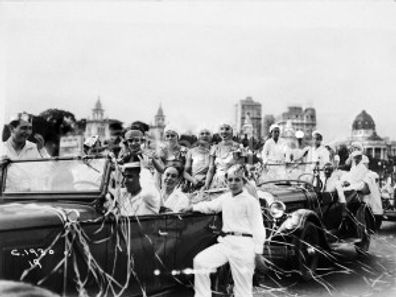


Carnaval has been one of the most popular celebrations in Brazil since the 18th century. Especially in Rio, the birthplace of samba music, the festival has become worldly known and a symbol of the city.
Catholic Portuguese settlers brought the festival to Brazil. The Pre-Lenten celebration officially lasted three days, until Ash Wednesday, the first day of Lent. The latter is a six week period of fasting and abstinence that ends in Easter. Eating red meat was forbidden during Lent. The origin of the word “carnival” comes from “carne levare”, which means “to remove meat”, or from “carne vale”, which means “farewell to meat”.
During the 18th and 19th centuries, people started to form groups to celebrate Carnaval, such as the Grandes Sociedades (Great Societies), the luxurious masquerade parades held by the elite; the Ranchos Carnavalescos, which were parades organized by the middle working class, and the so called Cordões, less organized parades which promoted the encounter of the elite with the lower classes on the streets. The entrudo, was a typical game played during the Cordões’ parades in which the people of popular classes, including slaves, mixed water, mud, and flour and threw at each other.
Samba plays an essential role in Carnaval celebrations. It is mixture of musical styles with a big influence of African rhythms adapted to the reality of Brazilian slaves. Samba songs were played in a circle among slaves with one person dancing at the center. Overtime, Samba underwent various transformations.


Rua Visconde de Caravelas (1930´s)

The first Samba song recorded in Brazil was Pelo Telefone in 1917, written by Donga, Mauro de Almeida, and Sinhô. After that, the samba conquered the music industry and by the mid 1920s, the popular music was broadcast by radio. Soon people of all social classes became fond of the music style. In the 60’s and 70’s, several composers, such as Cartola, Nelson Cavaquinho, Paulinho da Viola, and Martinho da Vila revolutionized the samba music. They revived the traditional samba style and mixed a few other rhythms to it. Nowadays there are many branches of samba, such as pagode, marchinhas, and samba-enredo.
Later on, the Cordões became known as blocos, bands which would parade through the streets playing improvised samba songs, called marchinhas. Today they make up the widely popular Carnaval de Rua (Street Carnival). Eventually, some blocos grew, became more organized, and gave rise to the Escolas de Samba (samba “schools”).
In 1929, the first Escola de Samba, called Deixa Falar, emerged in the city of Rio de Janeiro in the neighborhood of Estácio. Over the next few years, several new “schools” were created, such as Estação Primeira de Mangueira and Vai como Pode (today known as Portela). They started competing against each other. People disguised themselves, decorated their cars, and paraded along the streets.
Over the years, the number of samba schools and spectators greatly increased and, in 1983, the famous Brazilian architect Oscar Niemeyer was commissioned to build the Sombódromo in Rio de Janeiro, as the permanent site for the famous parade contest.
Nowadays, the competition among Escolas de Samba in the famous Sambódromo is one of the greatest attractions, together with the Blocos de rua, in the Brazilian Carnaval.
Isabela Laranjeira (´14)




Cinelândia, Rio de Janeiro - Carnival (1930´s)


